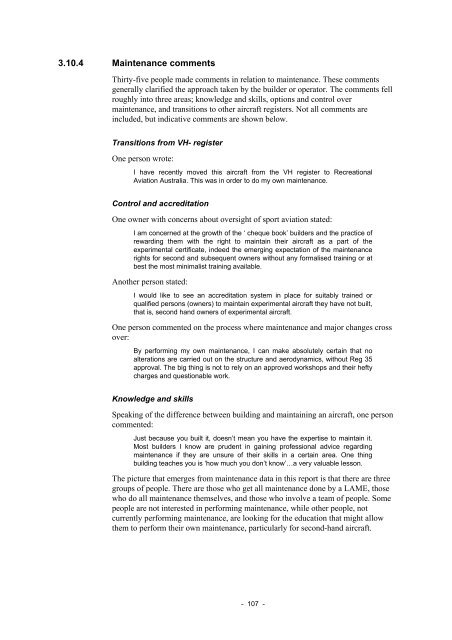Amateur-built and experimental aircraft - Australian Transport Safety ...
Amateur-built and experimental aircraft - Australian Transport Safety ...
Amateur-built and experimental aircraft - Australian Transport Safety ...
Create successful ePaper yourself
Turn your PDF publications into a flip-book with our unique Google optimized e-Paper software.
3.10.4 Maintenance comments<br />
Thirty-five people made comments in relation to maintenance. These comments<br />
generally clarified the approach taken by the builder or operator. The comments fell<br />
roughly into three areas; knowledge <strong>and</strong> skills, options <strong>and</strong> control over<br />
maintenance, <strong>and</strong> transitions to other <strong>aircraft</strong> registers. Not all comments are<br />
included, but indicative comments are shown below.<br />
Transitions from VH- register<br />
One person wrote:<br />
I have recently moved this <strong>aircraft</strong> from the VH register to Recreational<br />
Aviation Australia. This was in order to do my own maintenance.<br />
Control <strong>and</strong> accreditation<br />
One owner with concerns about oversight of sport aviation stated:<br />
I am concerned at the growth of the ‘ cheque book’ builders <strong>and</strong> the practice of<br />
rewarding them with the right to maintain their <strong>aircraft</strong> as a part of the<br />
<strong>experimental</strong> certificate, indeed the emerging expectation of the maintenance<br />
rights for second <strong>and</strong> subsequent owners without any formalised training or at<br />
best the most minimalist training available.<br />
Another person stated:<br />
I would like to see an accreditation system in place for suitably trained or<br />
qualified persons (owners) to maintain <strong>experimental</strong> <strong>aircraft</strong> they have not <strong>built</strong>,<br />
that is, second h<strong>and</strong> owners of <strong>experimental</strong> <strong>aircraft</strong>.<br />
One person commented on the process where maintenance <strong>and</strong> major changes cross<br />
over:<br />
By performing my own maintenance, I can make absolutely certain that no<br />
alterations are carried out on the structure <strong>and</strong> aerodynamics, without Reg 35<br />
approval. The big thing is not to rely on an approved workshops <strong>and</strong> their hefty<br />
charges <strong>and</strong> questionable work.<br />
Knowledge <strong>and</strong> skills<br />
Speaking of the difference between building <strong>and</strong> maintaining an <strong>aircraft</strong>, one person<br />
commented:<br />
Just because you <strong>built</strong> it, doesn’t mean you have the expertise to maintain it.<br />
Most builders I know are prudent in gaining professional advice regarding<br />
maintenance if they are unsure of their skills in a certain area. One thing<br />
building teaches you is ‘how much you don’t know’…a very valuable lesson.<br />
The picture that emerges from maintenance data in this report is that there are three<br />
groups of people. There are those who get all maintenance done by a LAME, those<br />
who do all maintenance themselves, <strong>and</strong> those who involve a team of people. Some<br />
people are not interested in performing maintenance, while other people, not<br />
currently performing maintenance, are looking for the education that might allow<br />
them to perform their own maintenance, particularly for second-h<strong>and</strong> <strong>aircraft</strong>.<br />
- 107 -

















